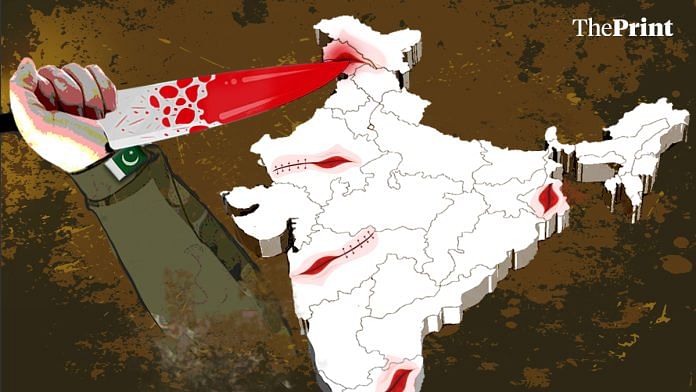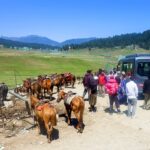At some point, their calculation has been, the Hindus will rise in reprisal against their own minorities. That’s a crisis they’ve been conjuring up in India. A nation at war with itself. At one level, it will be a kind of reverse schadenfreude—you are at war with yourself just as we’ve been with ourselves. At another, it will weaken and distract India tactically, militarily, politically and morally. The third is the most important. As India’s Hindu majority turns on their own minorities in anger and frustration, it will vindicate the two-nation theory.
Why do we call this the most important? Watch and read General Asim Munir’s speech to overseas Pakistanis on 16 April. If you count out his own falling credibility at home, as well as the bombast and Quranic invocations, you can read where the pain comes from. It is over the ideology of Pakistan, the two-nation theory that was demolished in 1971. That ideology is under renewed challenge by ethnic minorities in Pakistan’s western provinces. All of them are Muslims. Many of them want out so much that they are willing to kill and die for it.
So how do you still make the case for the two-nation theory and ideology of Pakistan? By proving that minorities, especially the Muslims, are persecuted in India—so thank you Quaid-e-Azam, even if he would probably have baulked at the general’s suggestion that Pakistan was formed on the basis of the Islamic . Or maybe the so properly anglicised Jinnah would’ve struggled to understand what this self-styled custodian of the ideology of Pakistan is saying, given his bad English.
The reason we start from about 45 years back is because that’s when it all changed, just after the Soviet invasion of Afghanistan, America and its western and middle eastern (especially Saudi) allies’ recruitment of Pakistan as their stalwart ally and the use of Islamic jihad as a strategy against the ‘infidel’ Soviets. If Communists could be declared infidels by Muslims, so could Hindus.
This started in about 1980-81 with the rise of Bhindranwale in Punjab. While initially he targeted the police and members of the Nirankari sect, soon enough, Hindus were in the crosshairs of his men. The first instance of clearly targeted and segregated killings of the Hindus came on 5 October, 1983. A bus on its way from the small town of Dhilwan to Kapurthala in Punjab was waylaid, six Hindus pulled out and shot.
This was the first targeted and selective terrorist killing of Hindus in modern history. So massive was this shock, it outraged India. Indira Gandhi sacked her own Darbara Singh government in Punjab and imposed President’s Rule.
In the following months, the selective killings of Hindus picked up, until it became the default terror attack template. This was followed by Kashmiri terror groups from 1989 onwards, beginning with the killings, persecution and forced exodus of Pandits, and spread across India as ISI-backed groups, or LeT members, targeted temples, weddings, holi and diwali celebrations, Ramlilas, Hindu religious processions and so on. At some point an Indian terror group, though fully aligned with ISI, also rose. The so-called Indian Mujahideen played havoc with serial bombings across India, including Delhi, 2005 (62 killed) and Jaipur, 2008 (63 killed), and Delhi again, 2008 (20 killed).
Over these 45 years, almost a hundred attacks targeting the Hindus have taken place. Until 1994 the attackers included terrorists from Punjab too. You can check out the South Asia Terrorism Portal (SATP) for definitive detail. Let me just mention a few, besides Delhi and Jaipur bombings.
In each case, the number of dead—all Hindus, unless the odd terrorist also died—is in parentheses. The Dhilwan bus attack (1983, 6 dead); Fatehabad bus attack (1987, 34); Lalru bus attack (1987, 38); Rudrapur Ramlila bombing (1991, 41); Ludhiana train massacres (1991, 125). And yes, that 125 is no typo. There was also the Chennai RSS office bombing (1993, 11); Lajpat Nagar blast in New Delhi (1996, 13); Dausa blast, Rajasthan (1996, 14); Coimbatore bombings (1998, 58); Attack on Amarnath yatris (August 2000, 21); Doda attacks (August 2000; 19); Raghunath Temple attacks, Jammu (March and November, 2002, 12 and 14 respectively); Akshardham Temple attack (2002, 33); Nadimarg massacre of Kashmiri Pandits (2003, 24); Delhi High Court bombings demanding the release of Afzal Guru (2011, 15) and so on.
This is just an indicative list out of more than a hundred attacks. It also doesn’t include serial bomb blasts on the Mumbai rail network and of course 26/11.
I’d believe this sad pile of facts is enough to make our central point: that the ISI strategy has been to use its direct and indirect proxies to target Hindus in India. They want an outrage and counter-targeting of India’s own minorities. Further, even the whiff of it restores Pakistan army’s popularity, especially when it’s in the dumps, like now.
I will take you back to the Bombay bombings of 1993. On the eve of the bombings, AK-47s and piles of grenades had been positioned in selected places—including the home of actor Sanjay Dutt. The idea was that, as with the post-Ayodhya riots which had recently taken place, the Shiv Sainiks would attack Muslim-majority localities and there, these weapons would be used to slaughter hundreds if not thousands of them, and the police. Who would be able to put out the fire it set across India then? M.N. Singh, then a top Mumbai cop, reminds us until then Maharashtra Police didn’t have even one AK-47.
Sharad Pawar sometimes gets bad press for revealing to me, in a WalkTheTalk, that he deliberately lied to say that one of the bombings was at a mosque. He wanted to buy time and get the police in place at sensitive points before any communal riots broke out. It was an astute and audacious move from an experienced leader. No riot followed the bombings. Bombay defeated the ISI.
You can call the Pakistani playbook Subversion 101. Inflict pain on India’s Hindus so brutally and for so long that they finally turn on their own minorities. That’s why even in Canada the Sikh radicals, aligned with the Pakistanis, attack and desecrate Hindu temples.
Let’s now see who understands this well. We can list people ideologically as far apart as Prime Minister Narendra Modi and the RSS, and Asaduddin Owaisi. Modi, in his speech in Bihar, didn’t use the word Hindu, or anything that would indicate a communal aspect. This was an extremely wise move. Was it a mere oversight? I’d be positive and read it alongside the statement from Dattatreya Hosabale, the putative number two in the RSS who described the Pahalgam attack as a massacre of ‘tourists.’ They know how important internal stability and calm is for India at this critical juncture.
This is also why Owaisi is using language for terrorists nobody in our politics, not even on the farthest Right of the BJP or warrior channels is using: . He knows the Pakistanis have delivered massive pain on the Hindus selectively. He wants to tell Hindus Indian Muslims stand alongside them. They are fellow citizens, not rejoicing enemies.
The Pakistanis and their ISI have again put the Indian majority’s patience under incredible pressure. It is just another, if the most brutal chapter in a playbook that has failed for more than 45 years. It is for us Hindus to make it fail again. We have only one country to call our own, after all.
And we’ve existed for more than 5,000 years, not created the other day based on some divisive ideology.








